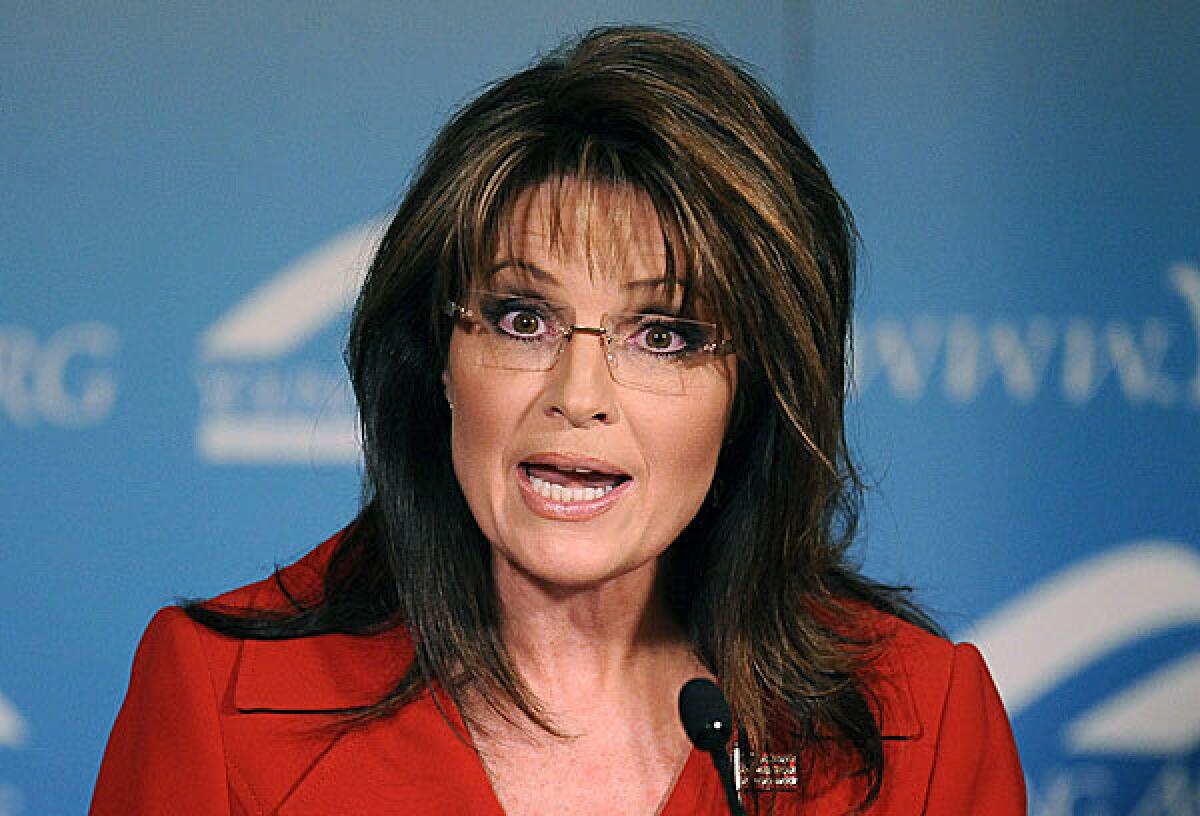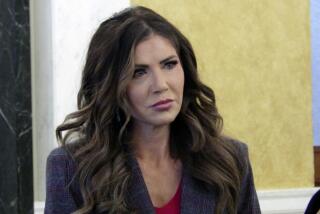Palin closely guarded her public image, emails show

- Share via
WASHINGTON AND LOS ANGELES — On a Saturday in July 2008, a letter to the editor on page B5 of the Anchorage Daily News caught Sarah Palin’s eye. The writer, Judy Spry, complained that the governor “didn’t even take the time to stop by” the annual Miss Alaska pageant held earlier in the month.
That morning, Palin sent her aides a draft letter to the editor defending her absence due to official business and noting that her husband, Todd, “left commercial fishing early this season to keep his commitment [to] judge” the pageant.
“I’m looking for someone to correct the letter writer’s goofy comments, but don’t want the letter to ADN in response to come from me,” she wrote her aides, suggesting they find someone else to forward it.
Such attention to defending herself against even the slightest criticism was a hallmark of Palin’s tenure as governor of Alaska, according to a newly released cache of her official emails. The thousands of pages of correspondence portray a governor engrossed in shaping how she was seen by others -- whether in a story about her family’s travel arrangements or coverage of complex policy initiatives.
After a reporter filed a public records request in July 2008 for the details of her family’s state-paid travel, Palin urged her staff to remind him of all the steps she had taken to save the state money by not having a chef or an apartment in Anchorage and by reducing her security detail. She suggested that her staff pull the travel records of previous governors, who she said took vacations with state security.
“We have to be proactive on this so pls let me know if you need any further info,” Palin wrote.
In the 24,199 pages of messages released Friday by the state of Alaska, Palin and her aides engage in extensive discussions about media tactics and the need to get out her side of the story. But there are few exchanges about the substance of the matters that came before her.
Gaining a full sense of Palin’s focus is difficult because the state heavily redacted her correspondence, particularly emails regarding policy discussions with her Washington staff. Many of those exchanges are stamped “privileged or personal.”
What emerges repeatedly in the materials, however, are episodes in which the governor pushed her staff to demand corrections from reporters and fretted that her emails were being leaked.
After the local media reported on email sent in May 2008 by the executive director of the state’s energy agency to its commissioners, Palin urged a staffer in the Department of Administration to track down the source of the leak: “This was an internal email from steve to all commissioners. It ended up in reporters’ hands. Not good, again.”
Palin and her aides also agonized over how to contain rumors that her eldest daughter, Bristol, was pregnant, which cropped up in the spring of 2008, after Palin had announced her own pregnancy. The governor considered contacting Sheila Toomey, the political gossip columnist for the Anchorage Daily News, to put the rumors to rest. “She can handle it light-heartedly, knowing her column and maybe it would go a long way,” Palin wrote. (Bristol gave birth to a son on Dec. 27, 2008.)
The vast majority of Palin’s emails went to a half a dozen of her close aides and her husband, Todd, indicating that she largely was cocooned within an insular circle of advisors on whom she relied for frequent updates. Based on the emails that were made public, she appeared to have limited direct contact with other Alaska lawmakers, even when major issues were before the state Legislature.
That approach was in keeping with the go-it-alone posture that defined Palin when she entered national politics, one that would probably persist if she jumped in the 2012 race for the presidency. (She has said she is considering an “unconventional and nontraditional” bid.)
Though her outsider stance brought her into sharp conflict with other lawmakers at times, Palin can point to significant accomplishments as governor. Perhaps most important was the 2007 passage of a tax increase on profits that oil companies paid to the state. Major oil companies strongly opposed her proposal, but Palin persevered after forming alliances with Democratic legislators. Passage of the tax led to a rebate check for Alaska residents during a year of high gas prices.
The emails showed that Palin and her staff sought to use policy victories to burnish her political image.
In June 2008, when it appeared lawmakers would take up her push for a temporary repeal of the state’s fuel tax, her jubilant staff crowed that the move would boost her standing as a possible vice presidential pick for Sen. John McCain.
“I’ll send to McCain’s camp after the presser or bill comes out,” staffer Ivy Frye wrote to Palin on June 19, 2008. “They’re going to love it! More vp talk is never a bad thing, whether you’re considering vp or not. I still say President Palin sounds better tho ...”
“Hee hee ...” the governor responded.
Even as Palin portrayed herself as anti-establishment, the emails reveal that the realities of governing were sometimes at odds with the political image she was crafting.
Palin won national applause for her 2008 vice presidential acceptance speech by telling the GOP nominating convention that she had told Congress, “Thanks but no thanks on that bridge to nowhere.”
In fact, as the emails reveal, Palin had an enormously complicated relationship with the $398-million Gravina Island Bridge project, which was to be funded mostly by $223 million in federal funds, as well as other projects financed by congressional earmarks. The bridge would have connected the city of Ketchikan with Gravina Island, home to the area’s airport and a few dozen people.
When she ran for governor in 2006, she gave a carefully honed answer about the Gravina project in a broadcast debate, saying that she would not stand in the way of the Alaska congressional delegation’s efforts to secure the funding.
Privately, however, she was not thrilled. In addition to the federal funds, tens of millions of dollars in state money would be needed to pay for the bridge. In 2007, she wrote to her chief of staff, Mike Tibbles, “I am very disappointed to hear that funds are still being spent on Gravina. The project does not have my support because of the funding issues long term.” But she did not propose returning the earmarked funds to the U.S. Treasury.
Though Palin wanted to be known nationally as a fiscal tightwad, back home “she did not want to be perceived as being against locally popular projects,” said Larry Persily, who worked as an aide in her Washington office.
In an April 2008 email to the state’s top lobbyist in Washington, Palin acknowledged that she welcomed federal funds for controversial public works projects. “Amazing that some still want to claim we’d essentially turn down federal dollars if they came via earmarked projects,” she wrote in an email to John Katz, who had sent the governor a newsletter article about the declining politically potency of earmarking.
matea.gold@latimes.com
robin.abcarian@latimes.com.
Gold reported from Washington and Abcarian from Los Angeles. Times staff writers Maloy Moore and Ken Schwencke in Juneau, Ben Welsh in Los Angeles, Kim Murphy in Seattle and Tom Hamburger, Kathleen Hennessey, Kim Geiger, Christine Mai-Duc and Melanie Mason in the Washington bureau also contributed to this report.
More to Read
Sign up for Essential California
The most important California stories and recommendations in your inbox every morning.
You may occasionally receive promotional content from the Los Angeles Times.













